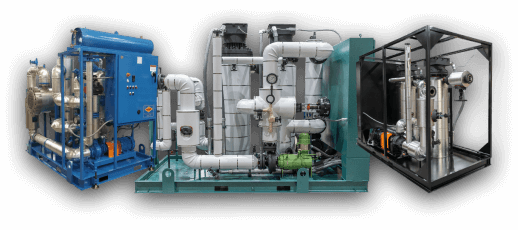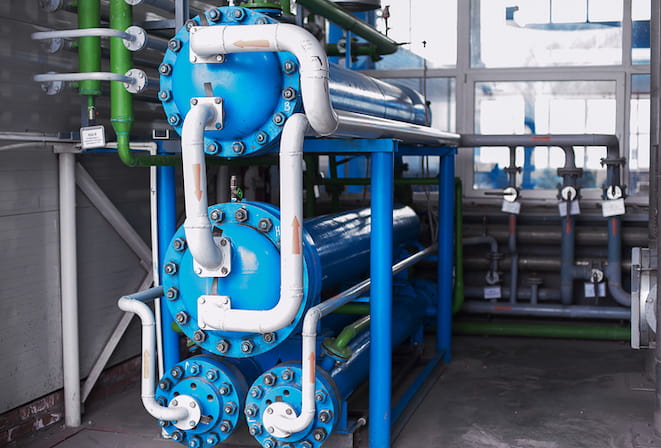How DVS Heat Transfer Systems Use Nanotechnology to Outperform Traditional Cooling Systems
Wiki Article
A Comprehensive Overview to Selecting the Right Heat Transfer Solutions for Your Demands
Selecting the ideal Heat transfer system is necessary for operational effectiveness. Numerous systems satisfy different requirements, affected by aspects such as temperature variety and liquid type. Comprehending the principles behind Heat transfer, such as radiation, convection, and conduction, is essential. In addition, reviewing energy sources and upkeep practices can affect long-lasting performance. A closer assessment of these factors to consider reveals just how to customize a system to certain requirements. What should one prioritize in this complicated decision-making procedure?Comprehending Heat Transfer: Secret Ideas and Principles
Although Heat transfer may seem like an uncomplicated concept, it encompasses a series of principles that are essential for reliable system style. Comprehending these concepts is essential for designers and engineers who intend to enhance thermal efficiency in numerous applications. Conduction, for circumstances, involves the transfer of Heat through solid products, while convection describes the motion of Heat within liquids. Radiation, one more key principle, explains exactly how Heat can be moved with electro-magnetic waves. Each of these systems plays an essential role in identifying how energy moves within a system. By thoroughly comprehending these concepts, specialists can make educated choices, ensuring that Heat transfer systems run efficiently and satisfy the details needs of their applications
Sorts Of Heat Transfer Systems: An Overview
Understanding the principles of Heat transfer lays the groundwork for exploring the different types of Heat transfer systems available. Heat transfer systems can be classified primarily right into three types: conduction, convection, and radiation. Transmission includes Heat transfer with solid products, counting on straight get in touch with in between fragments. Convection, on the other hand, happens in fluids (liquids and gases) where the movement of the fluid itself assists in Heat transfer. Radiation involves the transfer of Heat through electromagnetic waves and does not require a medium, allowing it to happen in a vacuum cleaner. Each sort of system has distinctive features and applications, making it crucial for people and organizations to very carefully examine their certain demands when choosing the most ideal Heat transfer service.Applications of Heat Transfer Systems in Various Industries
Heat transfer systems play an important function throughout different sectors, affecting effectiveness and product high quality. In commercial production processes, they help with accurate temperature control, while in food and beverage handling, they guarantee security and preservation. In addition, HVAC and climate control systems depend greatly on effective Heat transfer to maintain comfortable atmospheres.Industrial Production Processes

Many industrial manufacturing procedures rely greatly on effective Heat transfer systems to make best use of productivity and improve item top quality. In industries such as metalworking, Heat exchangers play an important function in maintaining optimal temperature levels during welding, spreading, and forging. These systems ensure consistent Heat circulation, which is essential for achieving desired product residential properties. In the chemical production industry, Heat transfer systems promote exact temperature control during reactions, influencing yield and safety and security. Furthermore, in fabric manufacturing, reliable Heat management is very important for dyeing and ending up procedures, affecting shade consistency and material quality. By choosing suitable Heat transfer innovations, manufacturers can boost energy effectiveness and minimize functional expenses, inevitably resulting in an extra sustainable and competitive manufacturing setting.
Food and Beverage Handling
Effective Heat transfer systems are just as crucial in the food and drink processing industry, where preserving perfect temperature levels is crucial for food safety and security and top quality. These systems play a crucial duty in processes such as sanitation, cooking, and pasteurization, making certain that items are safe for consumption and keep their nutritional value. Heat exchangers, as an example, efficiently move Heat between liquids, maximizing energy usage while lessening temperature level changes. Furthermore, refrigeration systems are fundamental for preserving disposable products and extending life span. The choice of Heat transfer innovation straight impacts operational effectiveness and product honesty, making it necessary for food and beverage producers to choose the ideal systems customized to their certain handling demands. This cautious choice ultimately adds to consumer fulfillment and food security.
Heating And Cooling and Climate Control
While several industries rely upon Heat transfer systems for effectiveness, HEATING AND COOLING (Heating, Ventilation, and Cooling) plays a necessary role in preserving interior environment control across numerous setups. These systems make use of Heat transfer principles to control temperature level, moisture, and air top quality, ensuring convenience and safety in household, industrial, and commercial environments. Correctly made HVAC systems enhance energy performance, lower functional prices, and minimize environmental impact. In industrial buildings, for circumstances, effective climate control adds to employee performance and consumer contentment. In commercial applications, a/c systems aid keep optimal problems for tools procedure and item conservation. Selecting the ideal Heat transfer system is crucial for meeting details climate control requirements and achieving general system performance.Evaluating Energy Sources for Heat Transfer Systems
In examining energy sources for Heat transfer systems, a comparison of eco-friendly energy options and fossil fuel considerations is necessary. Renewable resources, such as solar and wind, offer sustainable alternatives that can reduce ecological influence. On the other hand, fossil gas remain common due to their established infrastructure and energy thickness, triggering a cautious assessment of both alternatives.Renewable Resource Options

Fossil Fuel Considerations
Reviewing fossil gas factors to consider is important for the efficiency and sustainability of Heat transfer systems. Fossil gas, such as gas, oil, and coal, are typical power sources that give considerable Heat result, making them preferred selections for domestic and commercial applications. Their ecological impact, consisting of greenhouse gas exhausts and resource deficiency, elevates concerns. When choosing a warmth transfer system, it is important to analyze the schedule, expense, and regulative elements connected with these fuels. Additionally, the efficiency of nonrenewable fuel source systems should be thought about, as greater efficiency can reduce some ecological drawbacks. Eventually, a balanced technique evaluating performance and sustainability can direct decision-makers towards the most proper Heat transfer option for their specific needs.Variables to Think About When Picking a Heat Transfer System
Picking an ideal Heat transfer system needs careful consideration of various aspects that can substantially impact effectiveness and efficiency. One vital variable is the operating temperature variety, which determines the products and layout appropriate for the application. In addition, the kind of liquid made use of in the system-- whether gas or liquid-- influences Heat transfer effectiveness and compatibility. The system's dimension and capability should line up with the certain requirements of the operation to prevent inadequacies. Energy source availability is also necessary, influencing operating prices and sustainability. The installation setting, consisting of space constraints and accessibility for upkeep, plays a substantial duty in system selection. Regulatory conformity and safety standards must be considered to guarantee the system meets all legal needs.Maintenance and Efficiency Optimization for Heat Transfer Systems
Keeping Heat transfer systems is necessary her response for making sure maximum performance and long life. Regular upkeep activities, such as cleansing Heat exchangers and checking insulation, help protect against effectiveness losses due to Read Full Report fouling and thermal connecting. Additionally, keeping track of system parameters, consisting of stress and temperature, enables early discovery of abnormalities, minimizing downtime and expensive repairs. Applying a preventative upkeep timetable can optimize performance and prolong the life-span of components. Furthermore, upgrading to sophisticated control systems can enhance operational effectiveness by getting used to differing lots and conditions. By prioritizing maintenance and performance optimization, drivers can attain reduced power intake, lower functional prices, and boosted total system dependability, eventually causing far better resource utilization and a much more lasting operation.Future Trends in Heat Transfer Technologies
As industries progressively prioritize sustainability and power effectiveness, future patterns in Heat transfer technologies are set to go through significant transformations. Advancements such as innovative products, consisting of carbon nanotubes and nanofluids, guarantee improved thermal conductivity and effectiveness. Furthermore, the assimilation of renewable resource sources into Heat transfer systems is gaining energy, advertising environmentally friendly services. Smart innovations, including IoT sensors, are anticipated to revolutionize surveillance and control, allowing real-time information analysis for enhanced efficiency. The development of small and modular systems will certainly assist in much easier installment and upkeep, catering to varied applications. These improvements indicate a shift towards even more lasting, reliable, and adaptable Heat transfer remedies, aligning with worldwide power goals and ecological standards.
Often Asked Questions
What Are the Ecological Influences of Heat Transfer Equipments?
The environmental influences of Heat transfer systems can consist of greenhouse gas emissions, energy intake, and prospective thermal air pollution. In addition, inappropriate disposal of ineffectiveness and products can add to resource exhaustion and ecological community interruption.How Do I Compute the Cost-Effectiveness of a Warmth Transfer System?
To calculate the cost-effectiveness of a warm transfer system, one should analyze first prices, functional expenses, upkeep requirements, and energy efficiency, contrasting these variables against the expected life expectancy and performance of the system.Can Heat Transfer Equipment Be Made Use Of in Residential Settings?
Heat transfer systems can without a doubt be made use of in domestic setups. They give efficient home heating and cooling down original site remedies, making homes much more comfortable while potentially lowering energy expenses. Their versatility enables various applications in domestic environments.What Security Laws Relate To Heat Transfer Equipments?
Safety guidelines for Heat transfer systems usually consist of guidelines on procedure, upkeep, and installment. Compliance with local structure codes, producer requirements, and industry requirements is important to assure efficient and secure system performance in various applications.Exactly How Do Different Materials Affect Heat Transfer Effectiveness?

Conduction, for instance, involves the transfer of Heat with solid materials, while convection refers to the motion of Heat within liquids. Comprehending the concepts of Heat transfer lays the foundation for checking out the various kinds of Heat transfer systems offered. Heat exchangers, for circumstances, effectively transfer Heat in between liquids, optimizing power use while lessening temperature level changes. In examining energy sources for Heat transfer systems, a comparison of sustainable energy choices and fossil gas factors to consider is essential. Metals, such as copper and light weight aluminum, conduct Heat properly, whereas insulators like rubber and glass slow down Heat flow.
Report this wiki page